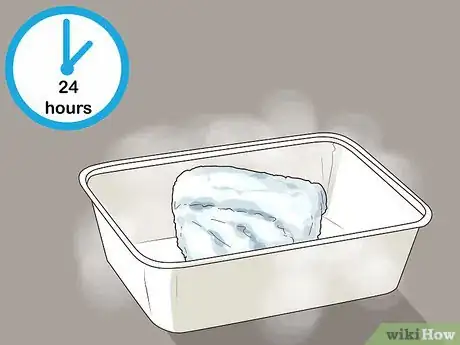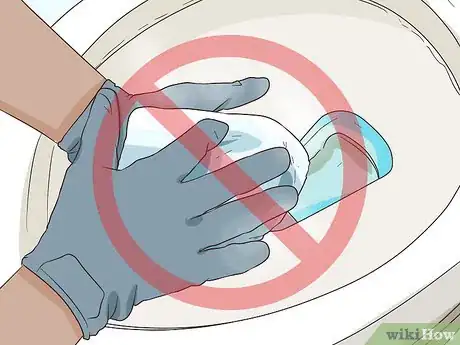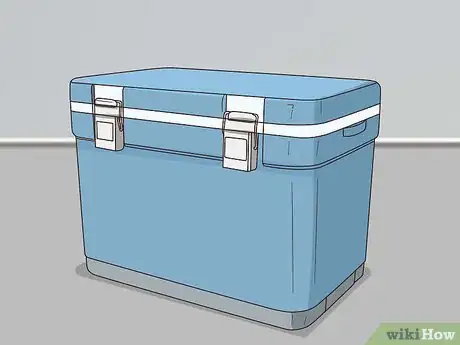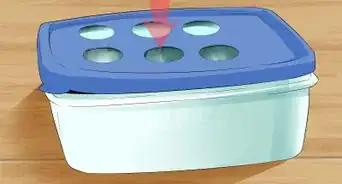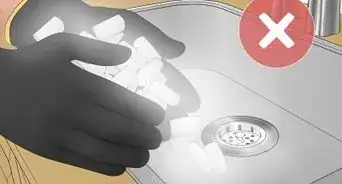This article was co-authored by wikiHow Staff. Our trained team of editors and researchers validate articles for accuracy and comprehensiveness. wikiHow's Content Management Team carefully monitors the work from our editorial staff to ensure that each article is backed by trusted research and meets our high quality standards.
There are 8 references cited in this article, which can be found at the bottom of the page.
wikiHow marks an article as reader-approved once it receives enough positive feedback. In this case, 83% of readers who voted found the article helpful, earning it our reader-approved status.
This article has been viewed 171,135 times.
Learn more...
Dry ice comes in flake, pellet, or block form. It is commonly used for transporting temperature-sensitive items, making fog effects, or doing scientific experiments. To get rid of dry ice, it is best to let it return to its gaseous form in an open space with good ventilation. Never leave dry ice a confined space, as it may cause an explosion or carbon dioxide poisoning.
Steps
Letting Dry Ice Sublimate
-
1Wear insulated gloves to handle dry ice. On contact, dry ice can harm your skin. After touching dry ice for a few seconds, you may experience burns or frostbite to the exposed skin. Never touch dry ice without wearing insulated gloves that will create a suitable barrier between your hands and the ice.[1]
- In a pinch, oven mitts or winter gloves are suitable for handling dry ice for a few seconds at a time.
- Nitrile exam gloves will not provide you any significant protection against dry ice. [2]
- Use tongs to handle dry ice when possible.
-
2Place dry ice in an open, well-ventilated area to sublimate. When left at any temperature under −109 °F (−78 °C), dry ice will transform from a solid to a gas. Place the dry ice in a well-ventilated space so that the carbon dioxide gas will disperse without causing harm to anyone. Keep the dry ice on a piece of styrofoam or hard plastic so that it won't harm your floor.[3]
- For instance, leave dry ice in a large room with open windows or on a secure balcony.
- If possible, choose an area that you do not spend a lot of time in to avoid exposure to carbon dioxide gas.
- Never place dry ice directly on a tiled or solid surface countertop as the extreme cold will damage it.
Advertisement -
3Let the dry ice sit for at least 1 day until it is completely sublimated. Depending on the volume of dry ice you have, it may take several days for it to completely revert to a gaseous form. Let the dry ice sit out in a well-ventilated area for 1 full day, then check on it to see if it has sublimated yet. Avoid spending too much time in this area to minimize your exposure to the carbon dioxide gas being released.[4]
- As a general rule, it takes about 24 hours for 10 pounds (160 oz) of dry ice to fully sublimate.
- Blocks of dry ice will take longer to sublimate than pellets or flakes.
Avoiding Problems
-
1Do not dispose of dry ice in areas accessible to the general public. Leaving dry ice in a shared hallway or other public areas will put others at risk of contact burns with the substance. It may also cause a build-up of carbon dioxide, creating an oxygen-deficient atmosphere. Always store or dispose of carbon dioxide somewhere inaccessible to the public.[5]
- Make sure animals can't get to dry ice when you get rid of it, as they may experience contact burns from it.
-
2Never dump dry ice into the trash or down a garbage chute. Dry ice needs to sublimate or evaporate in a well-ventilated area. A build-up of carbon dioxide vapor in a confined space could lead to an explosion, making it very dangerous. Always avoid disposing of dry ice in a garbage can, dumpster, or down a building's garbage chute.[6]
- An explosion could result in personal injury or property damage.
-
3Do not flush dry ice or try to wash it down a sink. The extreme cold emitted by dry ice can harm your toilet parts and pipes. Avoid trying to dispose of it in the sink as you might regular ice, which melts easily. Similarly, flushing dry ice down the toilet may seem like a fast and easy way to get rid of it, but you will likely cause lasting damage to your plumbing system if you do so.[7]
-
4Store dry ice in containers that allow the release of carbon dioxide gas. Before disposing of it, avoid keeping dry ice in any sealed container that is not specified for the storage of dry ice. These containers include styrofoam dry ice mailing containers and insulated dry ice storage containers. Purchase these from a shipping company or online from scientific equipment retailers.[8]
- Containers that are not specified for dry ice storage will not have the right insulation or ventilation to store dry ice safely.
- Styrofoam is a suitable storage material for dry ice since it is insulated but not airtight.
-
5Keep dry ice in the trunk if you are transporting it in your vehicle. The carbon dioxide released from dry ice can quickly fill up the cabin of a small passenger vehicle. This may cause the driver to feel ill or disoriented, increasing the risk of an accident. Always secure dry ice in the trunk of your vehicle if you have to transport it by car.[9]
- Avoid transporting dry ice over long distances.
Community Q&A
Did you know you can get answers researched by wikiHow Staff?
Unlock staff-researched answers by supporting wikiHow
-
QuestionCan you leave dry ice outside?
 wikiHow Staff EditorThis answer was written by one of our trained team of researchers who validated it for accuracy and comprehensiveness.
wikiHow Staff EditorThis answer was written by one of our trained team of researchers who validated it for accuracy and comprehensiveness.
Staff Answer wikiHow Staff EditorStaff Answer
wikiHow Staff EditorStaff Answer -
QuestionIs dry ice dangerous?
 wikiHow Staff EditorThis answer was written by one of our trained team of researchers who validated it for accuracy and comprehensiveness.
wikiHow Staff EditorThis answer was written by one of our trained team of researchers who validated it for accuracy and comprehensiveness.
Staff Answer wikiHow Staff EditorStaff AnswerIt can be dangerous if you don’t handle it properly. The main danger is that it can cause ice burns or frostbite if you touch it with your bare skin. If you allow it to sublimate in an enclosed space, too much carbon dioxide can build up in the area and make it hard to breathe. It can also cause an explosion if it sublimates in a small, tightly sealed container, like a garbage bag or small cooler.
wikiHow Staff EditorStaff AnswerIt can be dangerous if you don’t handle it properly. The main danger is that it can cause ice burns or frostbite if you touch it with your bare skin. If you allow it to sublimate in an enclosed space, too much carbon dioxide can build up in the area and make it hard to breathe. It can also cause an explosion if it sublimates in a small, tightly sealed container, like a garbage bag or small cooler. -
QuestionHow do you dispose of dry ice packs?
 wikiHow Staff EditorThis answer was written by one of our trained team of researchers who validated it for accuracy and comprehensiveness.
wikiHow Staff EditorThis answer was written by one of our trained team of researchers who validated it for accuracy and comprehensiveness.
Staff Answer wikiHow Staff EditorStaff AnswerDry ice is not usually put in packaging, like gel ice, since it could explode an airtight plastic bag as it sublimates. If there’s paper wrapped around the dry ice, take it off when you’re ready to dispose of the ice. You should be able to throw it away in the regular trash, but check with your local waste disposal company if you’re not sure.
wikiHow Staff EditorStaff AnswerDry ice is not usually put in packaging, like gel ice, since it could explode an airtight plastic bag as it sublimates. If there’s paper wrapped around the dry ice, take it off when you’re ready to dispose of the ice. You should be able to throw it away in the regular trash, but check with your local waste disposal company if you’re not sure.
References
- ↑ https://www3.nd.edu/~kamatlab/documents/Safety/Safe%20Handling%20of%20Dry%20Ice.pdf
- ↑ https://www.ehs.washington.edu/system/files/resources/dryice.pdf
- ↑ https://ehs.cornell.edu/research-safety/chemical-safety/specific-chemical-hazards/cryogenic-material-safety/dry-ice-tip-sheet
- ↑ https://ehs.cornell.edu/research-safety/chemical-safety/specific-chemical-hazards/cryogenic-material-safety/dry-ice-tip-sheet
- ↑ https://www.health.ny.gov/publications/7081/
- ↑ https://www.health.ny.gov/publications/7081/
- ↑ https://www.ehs.washington.edu/system/files/resources/dryice.pdf
- ↑ https://www3.nd.edu/~kamatlab/documents/Safety/Safe%20Handling%20of%20Dry%20Ice.pdf
- ↑ https://www.cganet.com/wp-content/uploads/Safe_Use_of_Dry_Ice_11x17-reduced.pdf
About This Article
To dispose of dry ice safely, start by putting on insulated gloves since dry ice can cause burns and frostbite if it touches your skin. Then, move the dry ice to a well-ventilated area, like a balcony or a large room with open windows. Let the dry ice sit for at least 24 hours until it's completely sublimated, or transformed from a solid to a gas. Never try to dispose of dry ice down a drain or in the trash since it can cause damage and a build-up of carbon dioxide. To learn how to drive with dry ice if you need to transport it, scroll down!


